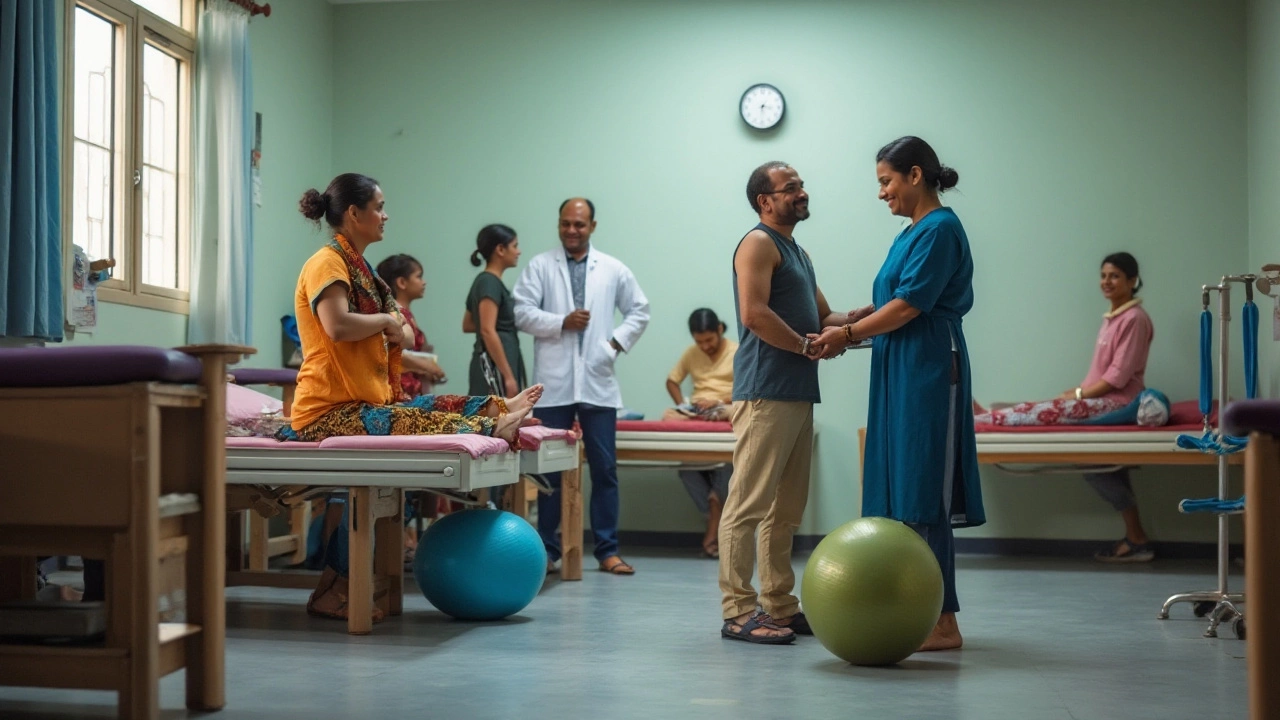Orthopedic surgery can be a life-changing intervention, often restoring mobility and alleviating pain for those in need. However, the journey to full recovery is not always straightforward. Some surgeries demand patience and resilience, with recovery times that stretch out over several months.
Diving deeper into what makes a surgery's recovery period lengthy, this article explores the aspects that play a crucial role. From the complexity of the procedure to the patient’s overall health, various factors can influence how quickly one can return to their routine. We delve into which surgeries typically come with the steepest recovery demands and offer practical tips to assist in navigating this challenging path.
- Factors Affecting Recovery Time
- Surgeries with Longest Recovery Times
- Patient Experiences and Challenges
- Tips for a Better Recovery
Factors Affecting Recovery Time
When it comes to orthopedic surgery, the road to recovery is often as significant as the procedure itself. Various components come into play in shaping the duration and ease of recovery time, making it essential for patients and healthcare providers to understand and consider these factors thoroughly. Among the prominent determinants is the complexity and nature of the surgery performed. More intricate surgeries, such as spinal fusions or total hip replacements, naturally call for extended healing periods due to their invasive nature and the substantial structural changes they bring about.
Beyond the surgery specifics, a patient's age can significantly sway recovery timelines. Typically, younger individuals experience quicker recovery, thanks to more robust cellular regeneration and metabolism. But that's not to say that older adults can't recover well; it's just that their bodies might require more time to accomplish the same progress. A person's general health status, including the presence of chronic conditions, plays an equally vital role in influencing how swiftly one can bounce back. Someone with comorbidities like diabetes or hypertension may need more time and care for an optimal recovery path.
Expectations around recovery are influenced by mental and emotional well-being as well. It's fascinating to note how a positive mindset can be incredibly beneficial during this journey. Resilience, support systems, and mental preparedness impact not only how patients perceive their recovery but also how effectively they can engage in rehabilitation programs.
"The mind is the lens through which the body views healing," says renowned orthopedic surgeon Dr. Mayer, emphasizing the role of psychological factors in the healing process.Moreover, the level of pre- and post-operative care is paramount. Patients who receive comprehensive rehabilitation services often find themselves on a smoother path back to health. Physical therapy exercises, designed to gradually restore mobility and strength, can bridge the gap between pain and potential, empowering patients throughout their recovery trajectory.
However, even with the best care strategies, complications might arise that extend recovery time. Infections, unforeseen injuries, or even surgical revisions may hinder initial recovery forecasts. These situations demand adjustments and patience, teaching a valuable lesson in adaptability. Another layer to consider is the patient's lifestyle, including their diet, sleep, and engagement in physical activity. A nutritious diet rich in proteins, vitamins, and minerals substantially supports healing by promoting tissue repair. Adequate rest, often underestimated, is, in fact, a cornerstone of successful recovery, allowing the body to focus its energy on healing damaged tissues.
In this interconnected web of factors guiding recovery, individualized care plans become essential. No two patients are alike, and understanding the unique interplay of these influences allows medical teams to customize recovery strategies that align with each patient's needs and circumstances. This personalized approach often fosters more meaningful interactions and outcomes, ensuring that the road to recovery is not only successful but also as smooth as it can possibly be for everyone involved.

Surgeries with Longest Recovery Times
When we talk about orthopedic surgery, certain procedures stand out for having notably long recovery periods. One prime example is spinal fusion surgery. This involves stabilizing the vertebrae by joining two or more of them together, often to relieve pain from conditions like scoliosis or herniated discs. The recovery time for this surgery can span from six months to a year, due to the intricate nature of the spine and the extent of healing required for bones to successfully fuse. Patients usually need to brace their patience as they navigate through months of restricted activities and physical rehabilitation.
Another procedure known for its extensive recovery is a total joint replacement, particularly the knee and hip replacements. These involve removing the damaged joint and replacing it with a prosthetic one, often necessary for those suffering from arthritis. While this surgery offers a new lease on life with reduced pain and improved movement, the path to experiencing these benefits takes time. Physical therapy is essential, starting from the hospital stay and extending for several months to regain strength and mobility. It's not uncommon for full recovery and complete adaptability to the new joint to take up to a year.
Rotator cuff surgery is another operation with a grueling recovery period. This shoulder surgery repairs torn tendons and is vital for restoring shoulder function and minimizing pain. Given the shoulder's range of motion and its role in many everyday activities, recovery can take anywhere from six months to a year. Patients often face a strict rehabilitation protocol, gradually moving from immobilization to active therapy to rebuild strength. Engaging in proper post-surgical care and exercises plays a crucial role in the recovery trajectory.
As Dr. James Andrews, a renowned orthopedic surgeon, once said, "Patience and discipline in recovery are as important as the surgery itself. The journey to full recovery is a marathon, not a sprint."Complex fractures, such as those that require open reduction and internal fixation, also come with lengthy recovery periods. These fractures happen when bones shatter into multiple pieces, necessitating surgery to realign them using pins, screws, or plates. Healing varies depending on the fracture location and the individual's capacity for bone growth, but it typically demands several months before the injured area can bear weight normally. Throughout this time, engaging with physical therapies and follow-up exams is crucial to ensure the alignment holds and the bone strengthens properly.
While each surgery has its unique challenges and timeline, the common thread is the emphasis on post-operative care. The effectiveness of the healing process is deeply connected to how well patients adhere to their doctor's instructions, pursue physical therapy, and maintain a positive outlook. Having realistic expectations and being adequately informed can make this trying but rewarding journey a little more manageable.

Patient Experiences and Challenges
When it comes to lengthy recoveries from orthopedic surgery, patience becomes a crucial ally for patients. Many individuals find that understanding their personal healing timelines greatly impacts their mindset and attitude toward recovery. A key challenge faced involves the unpredictability associated with recovery paths. Different bodies heal at varying rates, and it’s not uncommon for two people undergoing the same procedure to have vastly different experiences. Recovery is influenced by several variables, including the patient's age, previous health conditions, and even their commitment to post-operative care. These factors all come together to shape a patient's unique healing journey.
Being immobilized or restricted in movement can also lead to emotional struggles such as feelings of frustration or helplessness. For some patients, every small improvement can seem monumental, yet the road back to full health requires coping with these emotional hurdles as much as the physical ones. Many report feeling isolated when they can't participate in daily activities or do the things they once enjoyed. Therefore, maintaining a support system of friends and family is often highlighted as essential. Engaging in discussion groups or therapy can also provide a necessary outlet for emotional release and support. Additionally, expressing feelings through creative outlets such as writing or art can offer cathartic relief.
Managing expectations is another common challenge. Surgeons advise realistic timelines, but some patients expect quicker results, fueled by personal desires to resume their usual lives. Setting realistic goals with achievable milestones is a strong motivator. Celebrating small victories, such as the ability to walk a little farther or lift something slightly heavier, can empower patients, providing the necessary encouragement to stay committed to their recovery routine. Therapists often emphasize focusing on what patients can do rather than what they currently can't, encouraging a positive outlook.
Access to resources can distinctively impact recovery experiences. Not everyone has the luxury of extended physical therapy sessions or state-of-the-art rehabilitation equipment, which can limit their recovery progress. This disparity highlights the need for comprehensive home exercise programs that cater to different economic situations, allowing every individual to engage in effective self-managed therapy. Moreover, digital platforms have proven beneficial, offering virtual sessions and instructional videos to assist those unable to attend in-person therapy.
"Recovery is a unique journey for every person, and the journey's length should not be seen as a reflection of one's strength or determination," notes Dr. Emily Carter, a renowned orthopedic specialist.
Understanding and accepting personal and external constraints can be critical to navigating the lengthy recovery process efficiently. Ensuring that one is consistently educated about the healing process and what it entails keeps anxiety at bay and prevents setting unattainable standards. As patients progress, celebrating improvements, no matter how small, can maintain a positive focus throughout the recovery journey.

Tips for a Better Recovery
Embarking on the path to recovery after an orthopedic surgery often requires a blend of discipline, patience, and optimism. While successful outcomes can lead to a significant improvement in quality of life, the recovery process itself can be daunting. Here, we delve into how you can enhance your recovery journey post-surgery. First and foremost, adhering strictly to your medical team's advice cannot be overstated. This includes attending physiotherapy sessions diligently, as instructed. Studies have repeatedly shown that patients who follow therapeutic exercises tailored to their specific surgery often regain mobility at a faster rate and with greater efficacy.
Managing pain effectively is another cornerstone of a smoother recovery. Pain management goes beyond just the use of prescribed medications. Incorporate techniques such as deep breathing exercises and mindfulness meditation, which can reduce perceptions of pain and help with relaxation. Elevation and ice packs may be recommended to reduce swelling, but always follow your doctor’s guidance on such practices. Nutrition plays a crucial role, too. A balanced diet rich in protein and vitamins can significantly expedite tissue repair and muscle strengthening. Hydration is equally important since adequate fluid intake aids in reducing post-operative inflammation and flushes out toxins.
Complex surgeries like knee or hip replacements demand emotional resilience. The psychological aspect of recovery should not be ignored. It's vital to maintain a positive mindset and not rush things, recognizing progress in small milestones. Engaging with support groups, whether online or in-person, can also provide emotional reinforcement and valuable insights from those who have walked a similar path. Monitoring your progress and setting realistic goals will keep you motivated and less likely to become disheartened by temporary setbacks. A study published in the Journal of Bone and Joint Surgery emphasized that engaging with a supportive community significantly improves recovery outcomes.
"Successful recovery is not just about physical healing, but embracing the whole journey with a proactive and positive spirit," says Dr. Emily Warden, an esteemed orthopedic specialist.
With modern technology, some smart gadgets can assist your recovery. Devices that monitor your movement or track your steps can offer insights into your daily achievements and motivate you to maintain an active lifestyle within advised limits. Crafting a comfortable and accessible home environment ensures that the recovery phase is less stressful. Arrange frequently used items within easy reach to avoid movements that might strain healing tissues. In crafting your recovery plan, reflect on these strategies and adapt them to your unique circumstances, understanding that your dedication today will lead to a stronger, healthier tomorrow.
